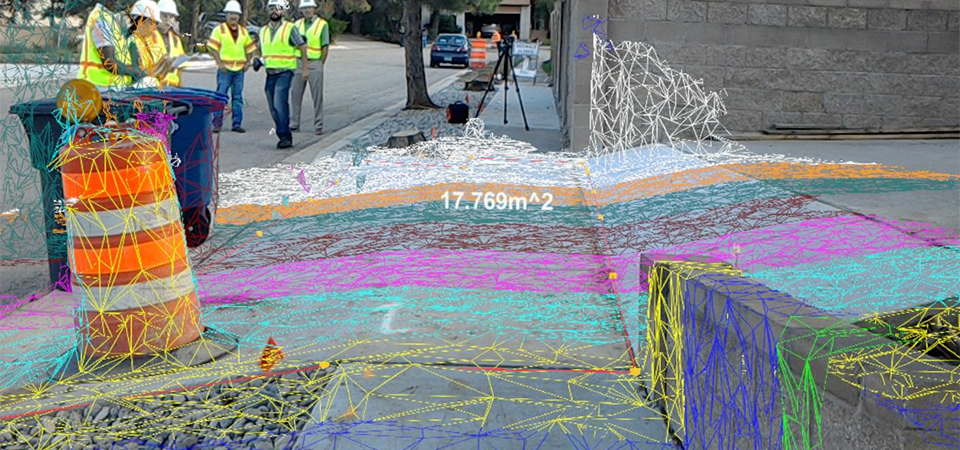Recent News
Grant Rudnick named Breece Award recipient
December 2, 2025
UNM wins demo award at International Workshop in Structural Health Monitoring
December 2, 2025
Ferenchak named chair of Transportation Research Board Pedestrian Committee
October 31, 2025
Ferenchak named APBP 2025 Research Professional of the Year
October 1, 2025
News Archives
Engineering team looks at using augmented reality to fix ailing infrastructure
April 29, 2019 - UNM Center for Advanced Research Computing

Civil infrastructure in the United States is in serious disrepair. In 2017, the American Society of Civil Engineers (ASCE) published an Infrastructure Report Card in which it gave the crumbling national infrastructure a dismal grade of D+ and noted that it is impeding the nation’s ability to compete in the thriving global economy. According to the report card, over 9 percent of the 614,000-plus US bridges are structurally deficient, and their average age is 43 years. The ASCE estimates it would cost $123 billion to address the issue of the deficient bridges.
Professor Fernando Moreu and his SMILab (Smart Management of Infrastructure Laboratory) team, headquartered at the UNM Center for Advanced Research Computing, aim to develop and implement next-generation smart sensing technologies and strategies, which will ensure safety, cost effectiveness, resilience, and sustainability of civil structures such as the nation's bridges.
Prior to obtaining his doctorate degree, Professor Moreu worked as a consulting engineer for over 10 years, mostly focusing on the structural design and construction of bridges and structures. He is a registered professional engineer. His prior exposure to the industry, design, and construction demands has formed the basis of his research interests and publications. He and his team have done extensive research in railroad overpass collisions, as well as the application of augmented reality (AR) technology for infrastructure inspection.
The team is currently searching for innovative ways to improve the inspection, assessment, and management of the nation’s bridges using new technology, in particular AR, drones, and low-cost sensors, which are used to collect and share information.
In a recent presentation at the New Mexico Department of Transportation (NMDOT) in March, Professor Moreu, together with his research assistants Marlon Aguero and Dilendra Maharjan from the Department of Civil, Construction, and Environmental Engineering, presented new ideas on how to maintain, manage, and repair infrastructure cost efficiently using AR in order to make informed decisions about maximizing and maintaining safe operations.
Many people are familiar with virtual reality that creates images in computer games. Augmented reality uses the real-world environment and enhances it. “It works by overlaying the known attributes of an object in the corresponding position on the computer screen, and in this way it allows integration of reality with virtual representations that are provided by a computer in real time,” explained Aguero. For instance, thanks to AR, an engineer looking at a bridge can see any deterioration such as cracks, along with information on past inspections.
“AR augments human vision. Whatever your eye misses, AR helps you catch that,” Maharjan said.
The SMILab team recommended using AR-based computer programs for manual and drone inspections, as well as applying AR to collect new information, check previous information, and then compile the data obtained for future reference. Using AR to view a bridge under inspection allows the NMDOT to check the progress of corrosion, collision damage, cracking, connection slippage, and splitting. It also allows inspectors to add new information and relay it to other engineers and staff.
“It will make workflow more efficient, productive, and intuitive for the inspector. NMDOT was very positive about it and knew they could use it for field inspection work. We have received great feedback from the NMDOT that confirms that it’s the kind of technology they want to use in the workflow,” Maharjan noted. For the time being, the SMILab project is still in the research stage and NMDOT will need to reach out to the state to see if it is willing to fund such a program. Depending on the outcome of the projects like these, Professor Moreu’s lab may decide to commercialize the technology. “The AR definitely leads to a more efficient use of time and labor and increases overall efficiencies”, said Aguero. The end result, they hope, will be a safer national infrastructure for all.
Photo courtesy of LANL Engineering Institute
